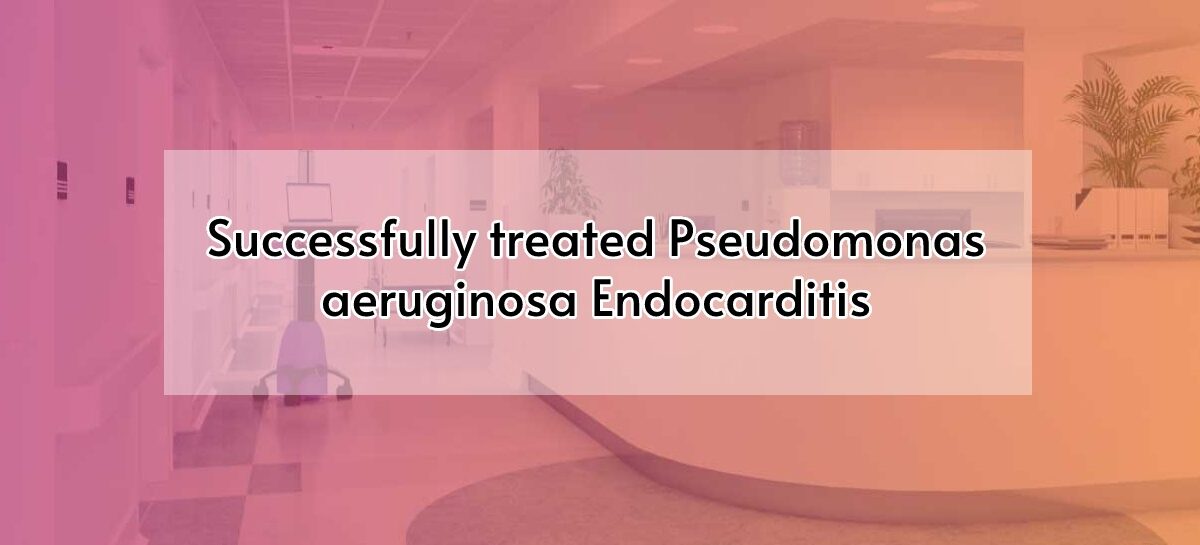Background:
Pseudomonas aeruginosa is a rare Infective endocarditis (IE) pathogen, accounting for 3% of all cases (1). It carries a very high mortality rate of 80%.
The cure rate of right sided IE reaches around 84% while that of the left sided remains 33% (2). According to a study, left-sided IE accounts for only 0.6% of all IE cases (3).
Here, we describe a patient with aortic valve Pseudomonas IE who was effectively managed with antibiotics, whose source of bacteremia was long term permanent catheter used for dialysis and got shifted to peritoneal dialysis later on.
Case Presentation:
A 31-year-old gentleman with known Diabetic, Hypertensive, Chronic Kidney Disease on Hemodialysis via Left Internal Jugular vein cannulation. Until a week ago, patient was on right permanent catheter for hemodialysis. H/O multiple vascular access failure was present. Patient presented to us with fever for 10 days. Echo revealed vegetation in aortic RCC cusp. Blood culture grew Pseudomonas aeruginosa. He was started on iv ceftazidime and levofloxacin. Hemodialysis was continued through Left IJV.
Vascular surgery deferred AV fistula as patient was on sepsis. Patient continued to be in volume overload state despite regular hemodialysis. 2 units of packed red blood cell was transfused for low haemoglobin.
Repeat Echo done after 28 days showed regression in vegetation over RCC cusp and a new vegetation in LCC. Patient was continued to be on antibiotics. After 48 days of antibiotics, repeat Echo showed no vegetation.
Since patient opted for Peritoneal dialysis, CAPD catheter was inserted 2 days later. CAPD exchange was done the following days gradually increasing the dwell volume and time. Haemodialysis was simultaneously done and slowly discontinued till the CAPD could remove good amount of ultrafiltration. Antibiotics were stopped a few days later. Peritoneal Equilibrium Test revealed low average transport.
As glucose is the predominant osmotic fluid used in peritoneal dialysis, it has been estimated that the daily dialysate glucose load could add up to 400-800kcal/day (5). The loss of protein during PD is very low. Patient improved dramatically since his admission. He was able to eat better, with no temporary line.
Peritoneal dialysis is usually started in the early phase of requirement of dialysis. Here late peritoneal dialysis was done after being in hemodialysis for 2 years. Patient is also counselled for renal transplant.
References:
1. Massardier, C.; Perron, J.; Chetaille, P.; Côté, J.; Drolet, C.; Houde, C.; Vaujois, L.; Naccache, L.; Michon, B.; Jacques, F. Right atrial catheter “ghost” removal by cardiac surgery: A pediatric case series report. Pediatr. Blood Cancer 2020, 67, e28197.
2. Grodstein, 1981; De Santo, 1979; Khar et al. 2019
3. Lin, T.I.; Huang, Y.F.; Liu, P.Y.; Chou, C.; Chen, Y.; Chen, Y.; Hsieh, K.; Chen, Y. Pseudomonas aeruginosa infective endocarditis in patients who do not use intravenous drugs: Analysis of risk factors and treatment outcomes. J. Microbiol. Immunol. Infect. 2016, 49, 516–522.
4. Bayer AS, Norman D, Kim KS. Efficacy of amikacin and ceftazidime in experimental aortic valve endocarditis due to Pseudomonas aeruginosa. Antimicrob Agent Chemother. 1985;28:781–5.





